The causes of a wet basement generally lie outside it, but even the best landscaping and gutter system may not solve the problem, and often cracks or holes in basement walls admit water that otherwise would stay outside. Much wetness can be eliminated by fixing interior walls, but work on the exterior may be necessary.
If the basement is damp but not wet—you see no patches of water but feel excess humidity or see its effects in mildew—the steps are fairly simple. Dampness may arise from water vapor generated by appliances in the house such as dish- and clothes washers—clothes driers are the worst offenders and their exhausts should be vented outdoors.
Seepage through walls or floor may introduce water as well as humidity, and sometimes humid air generated inside the house may condense into liquid on masonry surfaces, suggesting that moisture is entering from outdoors. To deter mine whether the problem is inside or outside—and whether ventilation is a sufficient solution—perform the following test. Tape a 16-inch square of heavy plastic sheeting to the wall below ground level. Remove it after several days: dampness underneath means that water is seeping into the basement between grains of sand and cement in a wall that looks solid. If the plastic-covered area is dry and the wall around it's damp, then water is condensing from moist air that's inside the basement.
If seepage is the problem, you may be able to block it with a coat of waterproof cement paint or, if necessary, layers of patching mortar over masonry interior walls and floor. A dirt floor is a common source of seepage; if you have one, cover it. Polyethylene plastic will do if you need not use the basement; if you must walk on the floor, lay sturdier covering—concrete or, at the least, roll roofing.
Cracks are more serious than seepage or condensation. They can be caused by settling, infiltrating tree roots, water pres sure against walls or floor, or even by minor earthquake tremors.
You may first notice a crack on a rainy day as water streams into the basement. The flood can be stopped and the crack fixed by channeling water out through a short hose, then plugging the leak with hydraulic cement, which hardens on contact with water.
Once the crisis has passed—or if you discover the crack before it floods the basement—check to determine whether it's a moving crack or a stationary one, since each type calls for a different remedy. Mark the wall or floor on each side of the crack and carefully measure the distance between the marks. Re-measure the distance after two weeks. If it's unchanged, the crack is stationary. A change in the space between the marks indicates a moving crack. Try repairing stationary cracks from the inside of the basement first. If such a patch proves ineffective by itself, the crack probably extends through the wall and you must seal the outside of the foundation too. A concrete patch will work for most cracks, but if the exterior wall of the foundation is badly damaged, you may have to excavate, patch and seal a large section of the wall.
Moving cracks almost invariably go through the wall. To seal hairline cracks effectively, you must make flexible interior patches out of fiberglass cloth and asphalt sealer. You can seal cracks up to an inch wide with mastic joint sealer, which is heated with a propane torch until soft and pushed with a putty knife into the crack. The mastic is then covered with a patching mortar.
Of all the cracks in a basement, the most troublesome are those that occur where the floor meets the wall. Try filling them with a joint sealer and epoxy resin, which are in turn covered by mortar. If this remedy fails to keep the basement dry, the only solution is to in stall a sump pump.
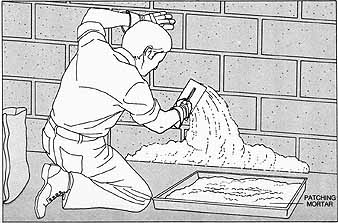
Preventing seepage. Dampen
the wall with a moist sponge and trowel on a ¼-inch layer of patching mortar
mixed with a waterproofing additive such as silicone or latex. Work from
the floor upward. After the cement dries but before it sets—about 20 minutes
to one hour—use a stiff brush to apply a coat of waterproof cement paint,
working the paint into the fresh cement.
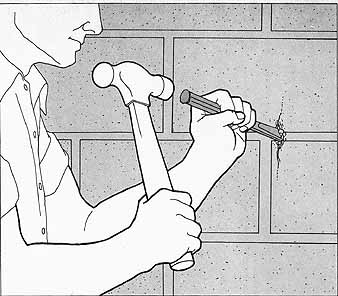
Patching stationary cracks.
Open the crack with a cold chisel until it's an inch wide, then remove
loose concrete with a wire brush. Use a pointing trowel to wet the surfaces
of the crack with patching mortar; then fill it with the mortar.
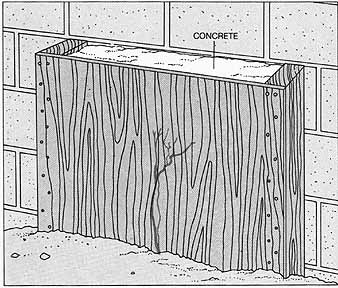
Small exterior cracks. Excavate
the wall a foot below and a foot beyond either side of the crack, then
build a three-sided form. Cut 2-by-4s long enough to reach between the
bottom of the excavation and 1 foot above the crack. Nail to these edges
½-inch plywood the length of the 2-by-4s and 2 feet wider than the crack.
Prop the form over the crack with 2-by-4 scraps and fill it with a standard
concrete mix. Let the concrete set 24 hours before removing the form.

Filling wall-floor cracks.
Widen the outside of the crack with a cold chisel, making a beveled slot.
Dry the crack with a propane torch and line the slot next to the wall with
a strip of mastic joint sealer 1/4 inch thick to keep out moisture. Half
fill the rest of the slot with liquid glue to prevent the mastic from loosening,
then mortar over the resin with a pointing trowel.
Repairing Small Moving Cracks
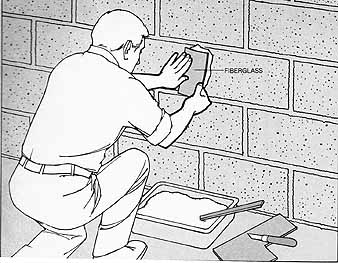
Repairing small moving cracks. Cut fiberglass
cloth—the kind sold for patching walls—to cover the crack completely and extend at least 2 inches on all sides. Using detergent, clean the crack and the part of the wall to be covered by the patch. Brush on a coat of
asphalt sealer, stick the patch to it, and cover it with more sealer.
Repairing Large Moving Cracks
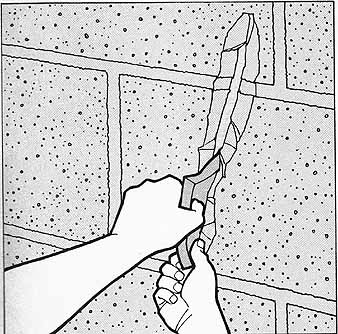
1 Preparing the crack. Chip
out the crack so that it's ¾ inch wide at the bottom and 1 inch wide at
the surface of the wall. If the wall is cinder block, cut strips of expansion
joint material, an asphalt-impregnated substance used between sections
of sidewalk. Stuff the material through the crack—using a screwdriver,
if necessary—to fill the hollow inside the block. 2. Sealing the
crack. Use a propane torch with a wide tip to soften mastic joint
sealer until it's soft, then press it into the crack with a putty knife.
Fill the crack about halfway, then, with a pointing trowel, fill the crack
to the top with patching mortar to complete the job.
Plugging Flowing Leaks
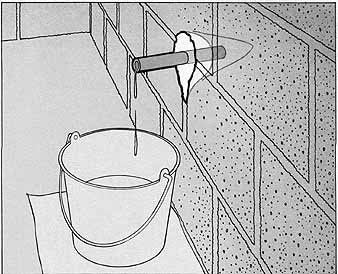
1. Inserting a bleeder hose.
Chip loose concrete away from the hole. Divert the water into a bracket
by inserting a piece of rubber hose— any size that fits—and fill around
it with dry hydraulic cement, which sets within a minute or two after it
comes into contact with water. It is available in hardware stores.
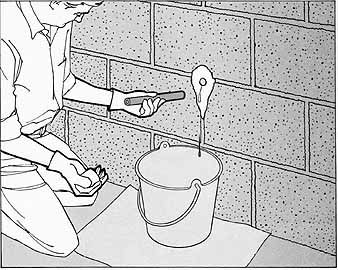
2. Inserting a plug. When
the hole around the hose is filled, shape a conical plug of dry hydraulic
cement, hold it in the palm of one hand, pull out the bleeder hose and jam the plug into the hole, holding it in place until the cement sets.